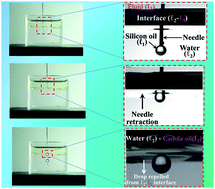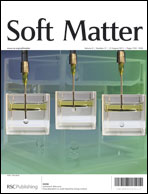Drop deposition on under-liquid low energy surfaces†
Abstract
In this paper, we propose a new technique for non-intrusive drop deposition on under-liquid low energy surfaces. This technique addresses the limitations of the conventional drop deposition method, in which a needle holding the drop is brought in close proximity to the solid substrate, and the drop gets deposited on the solid by detaching from the needle spontaneously owing to the favorable drop-substrate surface energy. Therefore, for low energy surfaces, irrespective of whether such surfaces are in air or under liquid, the fact that the drop-substrate surface energy is much smaller than the drop-needle surface energy, there are extreme difficulties in depositing the drop by getting it removed from the needle. In our proposed method, we address this limitation for the special case of under-liquid low energy surfaces. Under-liquid systems provide two distinct interfaces: first the surface–liquid interface where the drop is to be deposited and the second the liquid–fluid interface at the location where the liquid column ends. We achieve this non-intrusive, substrate-independent drop deposition method by depositing the drop from this liquid–fluid interface, by using the (un)favorable spreading behavior of the drop at this interface. Massive upsurge in use of low-energy under-liquid surfaces, requiring a correct estimation of the corresponding surface energy, makes our proposed technique extremely important and technologically significant.


 Please wait while we load your content...
Please wait while we load your content...